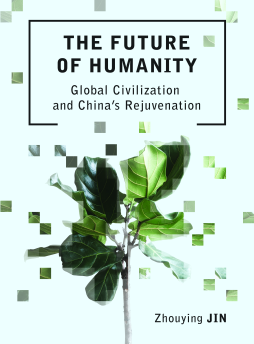
Additional Information
Book Details
Abstract
The Future of Humanity seeks to answer the question: ‘What kind of global civilization should human beings pursue?’, a question that has preoccupied scholars, philosophers and politicians for centuries. In doing so, the book tackles concepts as challenging as the keys to happiness, alien intelligence, immortality, morality and China’s possible role in bringing about a better world.
To navigate these many and complex topics, Jin combines the spiritual insights of ancient Chinese thinkers with a deep respect for the accomplishments and discoveries of modern Western science, and explores and explains her vision for a better, global, civilization.
Table of Contents
| Section Title | Page | Action | Price |
|---|---|---|---|
| Cover | Cover | ||
| Half Title | i | ||
| Title | iii | ||
| Copyright | iv | ||
| Contents | v | ||
| Preface : Theodore Jay Gordon | ix | ||
| Preface : Hazel Henderson | xiii | ||
| Preface : Guangbi Dong | xv | ||
| Comment | xvii | ||
| Acknowledgments | xix | ||
| Introduction: Where are Human Beings Headed? | 1 | ||
| Where is humanity headed? | 3 | ||
| Concerning human evolution | 4 | ||
| What is technology? | 4 | ||
| On future civilization | 5 | ||
| Sustainable development and human beings | 5 | ||
| Understanding China | 6 | ||
| Chapter 1: Deep Concern Over the Direction of Technology Development | 7 | ||
| The technological revolution now unfolding | 9 | ||
| The syndrome of technology worship | 22 | ||
| Anxiety disorder due to technology | 25 | ||
| Concerns over the direction of human evolution | 28 | ||
| Chapter 2: What Is Technology? | 39 | ||
| Technology in the broad sense | 41 | ||
| Soft technology has been ignored for a long time | 44 | ||
| The significance of understanding soft technology | 50 | ||
| What determines the direction of technological innovation? | 55 | ||
| Chapter 3: The Crisis in Human Civilization Driven by the Theory of Scientific and Technological Omnipotence | 67 | ||
| The imminent disaster facing science and technology | 69 | ||
| The crisis of human civilization | 72 | ||
| The integration of hard and soft technologies in the field of human life and its risks | 78 | ||
| Human progress as the ability to control their own destiny | 82 | ||
| Chapter 4: What Kind of Civilization Should Human Beings Pursue? | 91 | ||
| Exploring the future evolution of humanity from social-humanity perspectives | 94 | ||
| What kind of civilization should human beings pursue after the Industrial Civilization? | 96 | ||
| The Global Civilization: The cultural foundation for jointly building future human happiness | 98 | ||
| Chapter 5: Future Civilization and Sustainable Human Development | 113 | ||
| Redefining sustainable development | 115 | ||
| Human sustainability depends on what civilization we choose | 120 | ||
| Realizing sustainable development by adopting a systemic solution (the example of China) | 123 | ||
| Chapter 6: The Difficult Task of Creating a Global Civilization | 147 | ||
| The transformation of civilization has a long way to go | 149 | ||
| The development mode of each country can and should be unique | 159 | ||
| Basic principles | 162 | ||
| Beyond Global Civilization: The most worthy goal for human beings | 164 | ||
| Prospect of the Great Civilization | 167 | ||
| Chapter 7: Can Humans Eventually Create a Great Civilization? | 179 | ||
| The power of education and persuasion | 182 | ||
| Human beings can and should agree on common values | 183 | ||
| Ideal human societies have certain characteristics in common | 184 | ||
| Human beings have never stopped striving to realize the ideal society | 185 | ||
| Chapter 8: Global Civilization and China’s Rejuvenation | 207 | ||
| Promoting green and innovative production activities (transforming the economic development model) | 210 | ||
| Protecting and recycling natural resources and economizing to attain reasonable development (transforming the resource application model) | 213 | ||
| Repairing, restoring, and protecting the environment (transforming the ecological protection model) | 219 | ||
| Promoting social progress, building a harmonious society (transforming the social development model) | 224 | ||
| Population trial (transforming the population development model) | 228 | ||
| Striving to build an innovative country (from imitative innovation to independent innovation) | 232 | ||
| Institutional experiment (implementing a socialist system with Chinese characteristics) | 248 | ||
| China 2050: A splendid future lies ahead, but dangers still exist | 257 | ||
| Chapter 9: The Responsibility of Our Generation | 267 | ||
| Reaching a consensus is key | 269 | ||
| Changing how we think is the precondition for achieving consensus | 270 | ||
| Education | 273 | ||
| A better future cannot be predicted, but it can be created | 274 | ||
| Tolerance and visionary thinking | 275 | ||
| Be bold to take responsibility | 275 | ||
| Transmitting the goal of realizing the Great Civilization to the next generation | 276 | ||
| Bibliography | 279 | ||
| Notes on the Author | 297 | ||
| Back Cover | Back Cover |
